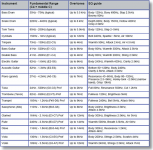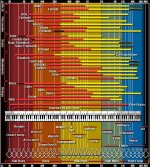I have a different take on the 400,000 rule...as i still think it has sound engineering underpinnings.
It's purpose imo, was to establish a geometric mean for the commonly accepted range or hearing. 20Hz * 20,000Hz
The square root of 400,000Hz squared is 632Hz, .....and the center of the octave spectrum.
It's like a see saw in it's application, with the fulcrum at 632Hz.
I think it's far more applicable when either end of the spectrum is severely limited...tilt's the see-saw more.
For instance, if highs only extend to 8kHz, a level bass response much below about 50Hz will make the overall sound tonally dull;
or tonally bright if bass truncates at say 70Hz, and highs are not held to about 6kHz.
I think the reason that maybe some hi-fi enthusiasts don't find value in it, is their speakers don't violate the balance much.
Just as a long see-saw is less imbalanced by minorly different lengths from the fulcrum, so is the 400,000 rule when response is nearly full range.
Width of response determines length of see-saw....when shorter, like in the 50Hz to 8kHz range, imbalances in length from fulcrum occur faster.
Not something most hi-fi enthusiastic encounter.
Another thing i really like about the see-saw idea and the center of the spectrum being 632Hz, is like many people, i often prefer a downward sloping frequency response curve.
I've found 632Hz to be the best hinge point, ie 0dB point, on the relative response curve I can find. Muck better than B&K etc ime.
A straight like response sloping down just like a see-saw....
I simply vary the amount of tilt to taste. WORKS GREAT 🙂
Highly recommended for remastering tracks !!!!
(I use 640Hz for simple math, octaves up or down)
It's purpose imo, was to establish a geometric mean for the commonly accepted range or hearing. 20Hz * 20,000Hz
The square root of 400,000Hz squared is 632Hz, .....and the center of the octave spectrum.
It's like a see saw in it's application, with the fulcrum at 632Hz.
I think it's far more applicable when either end of the spectrum is severely limited...tilt's the see-saw more.
For instance, if highs only extend to 8kHz, a level bass response much below about 50Hz will make the overall sound tonally dull;
or tonally bright if bass truncates at say 70Hz, and highs are not held to about 6kHz.
I think the reason that maybe some hi-fi enthusiasts don't find value in it, is their speakers don't violate the balance much.
Just as a long see-saw is less imbalanced by minorly different lengths from the fulcrum, so is the 400,000 rule when response is nearly full range.
Width of response determines length of see-saw....when shorter, like in the 50Hz to 8kHz range, imbalances in length from fulcrum occur faster.
Not something most hi-fi enthusiastic encounter.
Another thing i really like about the see-saw idea and the center of the spectrum being 632Hz, is like many people, i often prefer a downward sloping frequency response curve.
I've found 632Hz to be the best hinge point, ie 0dB point, on the relative response curve I can find. Muck better than B&K etc ime.
A straight like response sloping down just like a see-saw....
I simply vary the amount of tilt to taste. WORKS GREAT 🙂
Highly recommended for remastering tracks !!!!
(I use 640Hz for simple math, octaves up or down)
trying to attach a chart showing several musical instruments and their overtones...let's see if it shows up...
Any instrument involving one thing hitting another will show a large series of overtones, right up to ultrasonic.
The kick drum one is particularly inaccurate. Even Shure's Beta-52a reaches higher than 3.5kHz.
I stand by my previous post, that the 400,000 rule has so many holes as to render it useless.
Chris
Well at least for me it has never sounded better than some other reasonable ratio, so I no longer try to achieve it. Does 40-10k Hz sound better balanced than 25-10k Hz? Not to me it doesn't.
Perhaps it's one of those things we wish were true, because it's easy.
Perhaps it's one of those things we wish were true, because it's easy.
Well at least for me it has never sounded better than some other reasonable ratio, so I no longer try to achieve it. Does 40-10k Hz sound better balanced than 25-10k Hz? Not to me it doesn't.
Perhaps it's one of those things we wish were true, because it's easy.
I agree, I'd take 25-10k Hz in a heartbeat.
Like i was trying to portray, if neither end of the spectrum is seriously constrained from a 'how many octaves are missing point of view', the rule doesn't mean much.
I mean, 10k to 20k is just one octave missing....
But when significant octaves on either end are missing, I think the rule works very well, because it is more about our hearing and what sounds tonally right under greatly reduced bandwidth.
So, not a hi-fi rule.... but quite applicable to ceiling speakers, for example.
What I really like about the "rule", is that it helped me to see the center of gravity in the spectrum....5 octaves below....5 octaves above. Approx 640 Hz.
And how our hearing likes some tonal balance when the spectrum is shortchanged on either end.
And another totally cool thing, it helps me visualize power and displacement needs across the spectrum on an octave basis....
for what ever downward tilt i apply to frequency response, on top of a flat linear response.
It's pure power needs, added on, or subtracted to.... from linear.
(sorry, couldn't resist 😉 )
I have essentially 15 Hz to 15 KHz in room confirmed only by my two ears; Measurement system here now but I still am on the very sharp rising part of the learning curve here. If you can get 40 Hz to 8 Khz with minimal attenuation; you have probably WELL over 95% of the recorded music covered and everything else above and below is just gravy (an old saying; same meaning as icing on the cake or cookie)...
40HZ yes, but on a lot of music, especially vinyl, I see notable content up to 10K, then not much above that. So 8K might be selling yourself a little short. Cutting off at 7K definitely takes warmth away from the strings.
Mark, that is interesting. I mean I'm familiar with fixing a thin and bright spectrum by turning up the bass. It works even though it leaves much of the problem unfixed.
On one hand I could say a properly balanced system will sound fine if I switch in/out sub 60Hz.
Secondly, what to do if the band is limited by our own hearing?
On one hand I could say a properly balanced system will sound fine if I switch in/out sub 60Hz.
Secondly, what to do if the band is limited by our own hearing?
You have to go out of your way to run into Earl just recently. Let's hope he's been enjoying quality time with those he cares for.GM said:hope to get Dr. Geddes and/or others thoughts on all this
The crucial question to ask is whether perception of the same sounds change with aging? When one tests perception of pure sine tones, is it established, age causes the audible spectrum to shrink at both extremes. Does this shrinkage affect realistic sounds, which are in their vast majority, very complex waveforms involving many frequencies at the same time?
Agree, yes but we still know what the sound is. It gets subjective. We can still reason the properties - source direction, distance, how hard an object was struck..
40HZ yes, but on a lot of music, especially vinyl, I see notable content up to 10K, then not much above that. So 8K might be selling yourself a little short. Cutting off at 7K definitely takes warmth away from the strings.
Agree!
I have seen better charts and graphs showing harmonic and overtones of common musical instruments. I'll see if I can find some better ones today. Even an electric bass can have rich overtones well past 7 KHz. Violins, violas, etc. go WAY past 10 KHz, electric guitars can really have very rich overtones as well.
What is the highest note on a piano? Almost 4200 Hz; as it is not a pure sine wave; harmonics, overtones, etc. reach well above this.
More later, first coffee...
Table of Musical Notes and Their Frequencies and Wavelengths
notes and frequencies chart just for starters here...
Note names of musical notes keyboard piano frequencies = octave piano keys number tone tones 88 notes frequency names of all keys on a grand piano standard concert pitch tuning German English system MIDI 88 - sengpielaudio Sengpiel Berlin
Doesn't go into harmonics, etc. but this is a good reference for those of you not musicians.
This shows the math that goes into musical notes relating to frequencies; etc.
Doesn't go into harmonics, etc. but this is a good reference for those of you not musicians.
This shows the math that goes into musical notes relating to frequencies; etc.
Tech Stuff - Frequency Ranges
Still not the exact one; I'll keep looking. This does have good info though.
Still not the exact one; I'll keep looking. This does have good info though.
https://cms-assets.tutsplus.com/uploads/users/1170/posts/25651/image/main_chart-610x677.jpg
see if this opens; I'll also try to do the attachment with the paper clip icon...
see if this opens; I'll also try to do the attachment with the paper clip icon...
Agree, yes but we still know what the sound is. It gets subjective. We can still reason the properties - source direction, distance, how hard an object was struck..
Sounds like more anecdotal theory and wishful thinking to me 😉
Psychoacoustics is a funny thing; not very well understood. My reading assignment for this morning I suppose!
https://acousticstoday.org/wp-conte...ychoacoustics-A-Brief-Historical-Overview.pdf
Looks like a good place for me to start...
Looks like a good place for me to start...
- Home
- Loudspeakers
- Multi-Way
- Frequency Response Match for Older Ears

